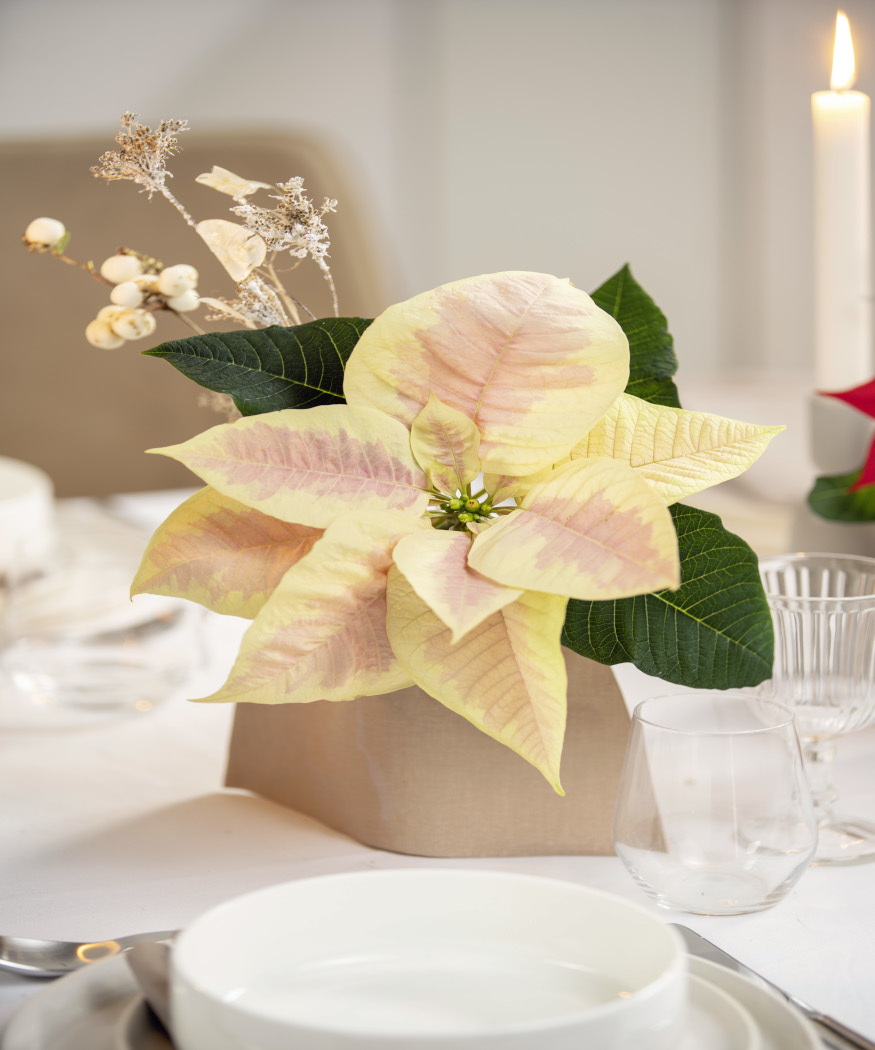The festive season is over. But your poinsettia isn’t finished yet. Instead of throwing it away, why not turn it into a beautiful, sustainable table display? Our simple idea will make it the centrepiece of your winter table. It’s easy, unique and requires little effort.
Christmas is over. The Christmas tree has been taken down and the fairy lights and garlands have been put away. What about your poinsettia? Many people quietly put it to one side or throw it away. That’s a shame, because it still has so much beauty to offer. With just a few simple steps, it can be transformed into a beautiful table decoration after Christmas. Natural, homemade and sustainable. Transform a forgotten plant into a heartfelt craft project. Your table will still look inviting for you and your visitors in the New Year. And you won’t need to buy anything new. It’s simple, mindful and low-waste.
Want to learn how to transform your old poinsettia into a beautiful new table decoration?
In our step-by-step video, we show you how to create decorative items for your home in winter using simple items you already have.
Table of contents
- Instructions: Using poinsettias as a table decoration after Christmas.
- Why poinsettias are perfect for winter decorations
- Stylish winter table decorations to suit every style, from urban to Scandi.
- Sustainable winter decor: Four low-waste hacks
- Why table decorations are good for you
- Interior design: The poinsettia is back — and more beautiful than ever!
- FAQ: Everything you need to know about poinsettias and winter decorations
- Five things you (probably) didn’t know about poinsettias
- Expert knowledge: How to properly care for poinsettias and keep them healthy for longer
- Glossary
Instructions: Using poinsettias as a table decoration after Christmas.
Do you still have a poinsettia at home? Perfect! This idea is for anyone who wants to create something beautiful with their plant without wasting it. Simply cut off a few stems and arrange them in a vase you’ve made yourself from things you already have. This creates a simple but stunning winter display, perfect for a breakfast with friends in the New Year or a New Year’s Eve party.
What you need for your sustainable table decoration
- empty glass bottles, such as smoothie or drinks mixer bottles
- wallpaper scraps
- scissors
- pen
- a vase template (you can draw this yourself)
- needle and string or hot glue
- A poinsettia plant
- a glass of hot water (approx 60°C)
- a glass of cold water
Step-by-step: How to transform your poinsettia into an attractive table decoration after Christmas.
1 . Prepare the bottles
Rinse the empty glass bottles thoroughly and remove the labels. These will become your vases later.
2 . Cut out the vase shapes from the wallpaper
Use a template or draw a vase shape straight onto a piece of wallpaper yourself. Cut out the shape and trace it onto a second piece of wallpaper. This will give you a front and a back. Make sure the size of each vase corresponds to the size of the bottle.
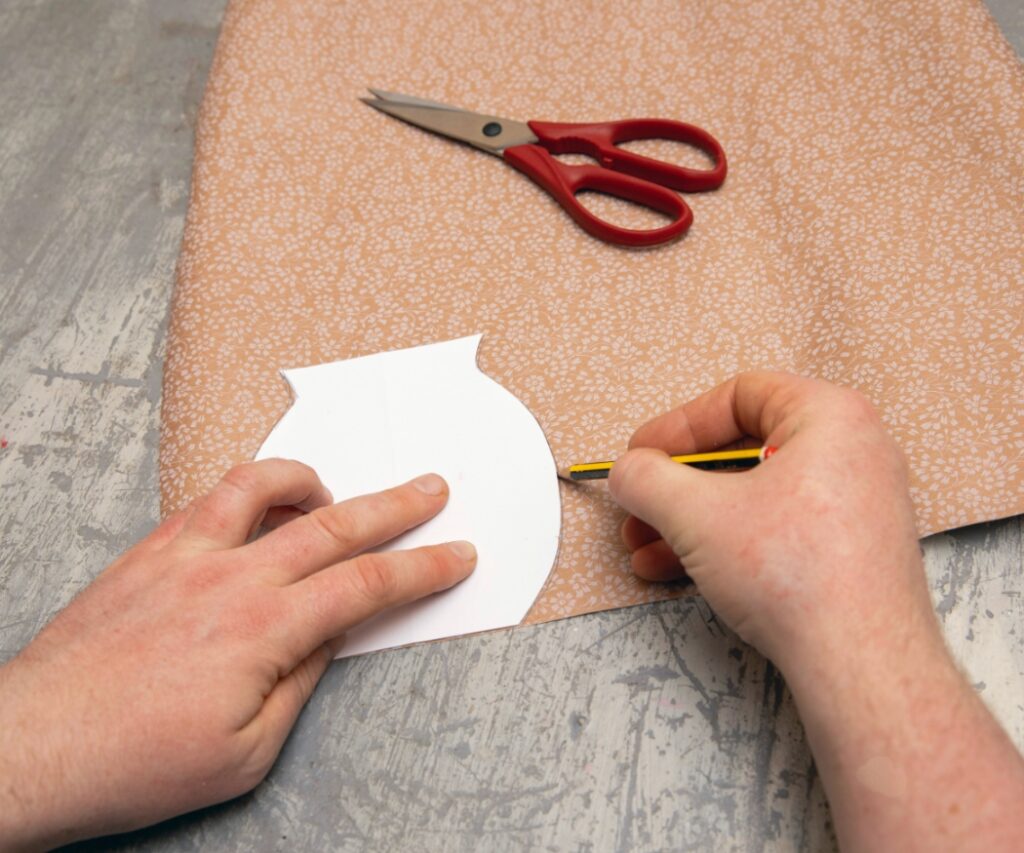
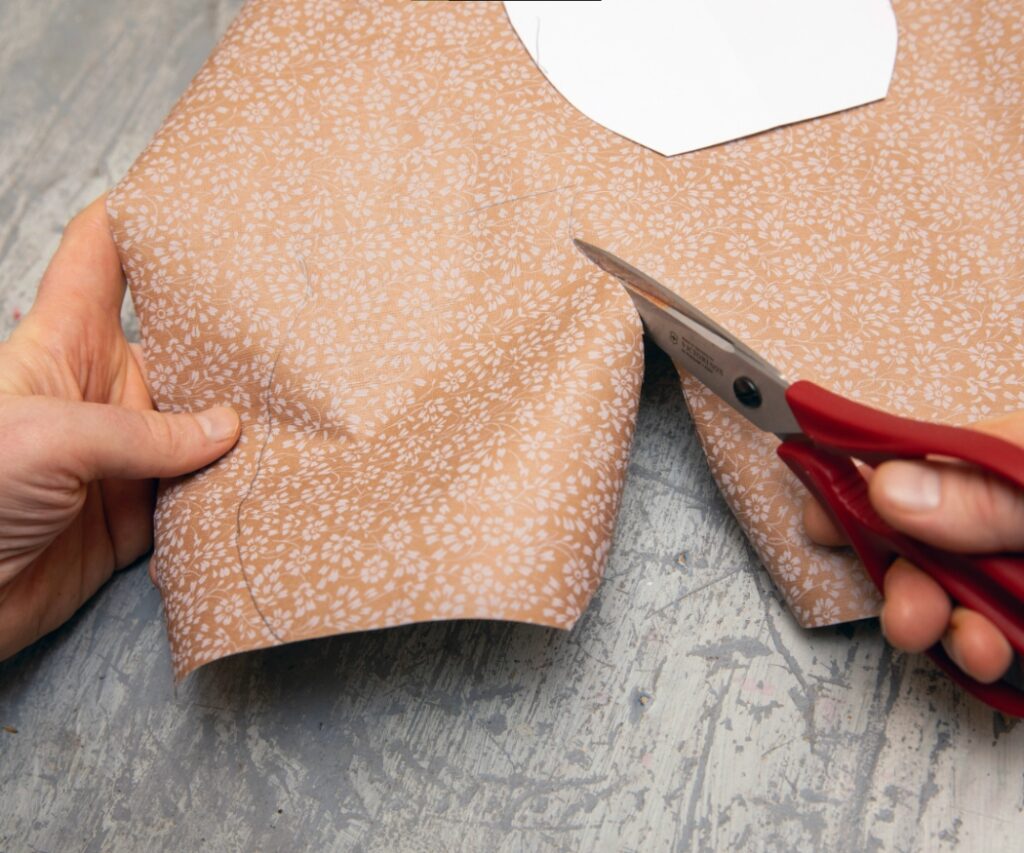
3 . Assemble the covers
Place the two pieces of wallpaper on top of each other with the reverse sides facing inwards. Sew or glue them together along the sides. Leave the top and bottom open so that you can slide the bottle inside later. Repeat with all the vase covers.
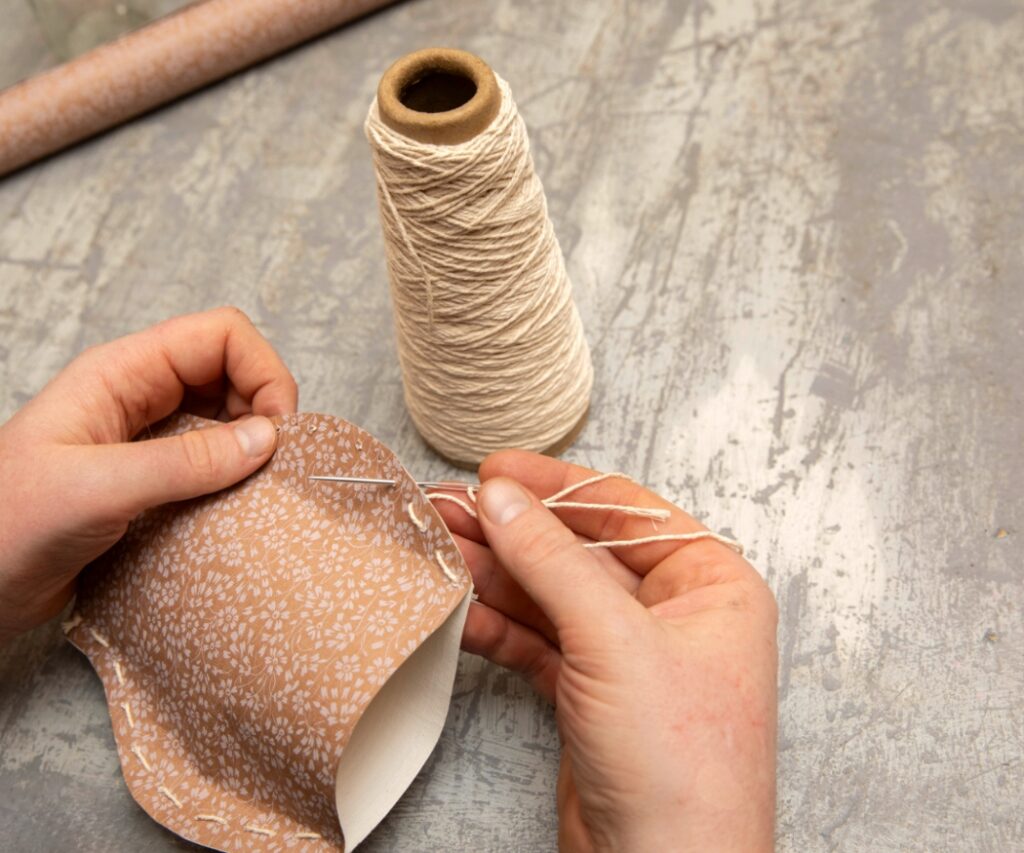
4 . Finishing the vases
Fill your bottles with room-temperature water, then place the corresponding cover over each one.
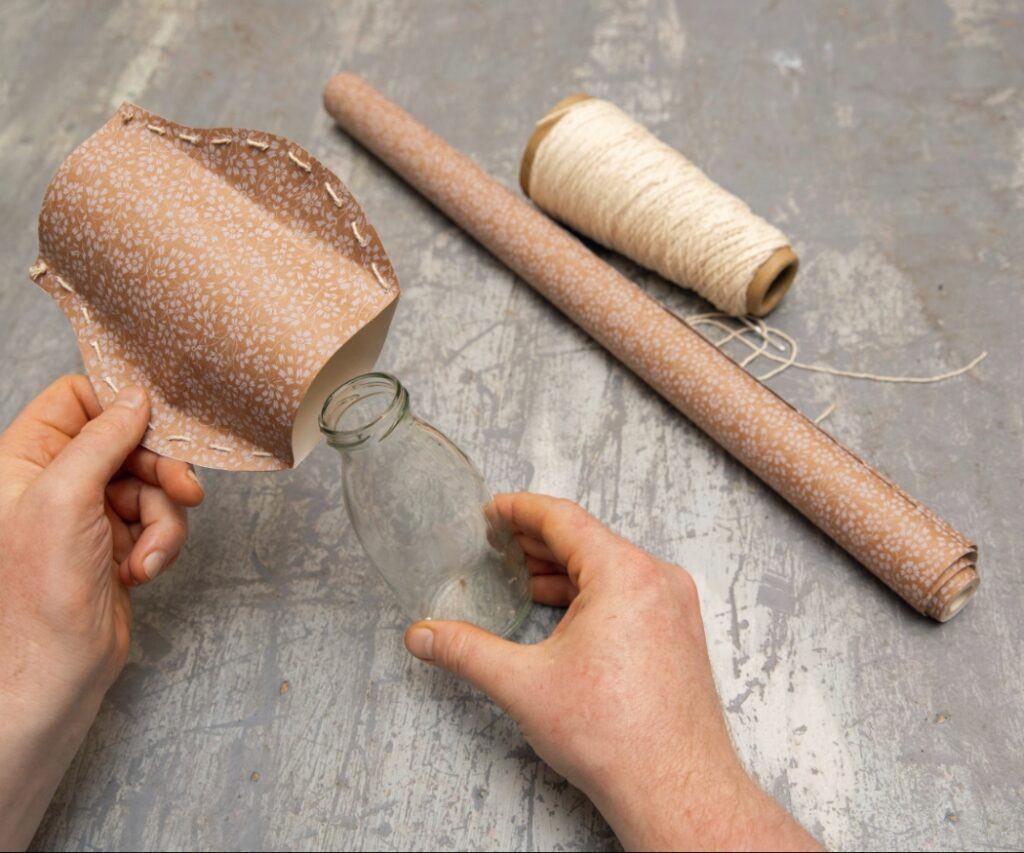
5 . Cut and prepare the poinsettia stems
Cut the stems off the poinsettia. Immediately place the cut ends in the glass of hot water for a few seconds, then place in the glass of cold water.
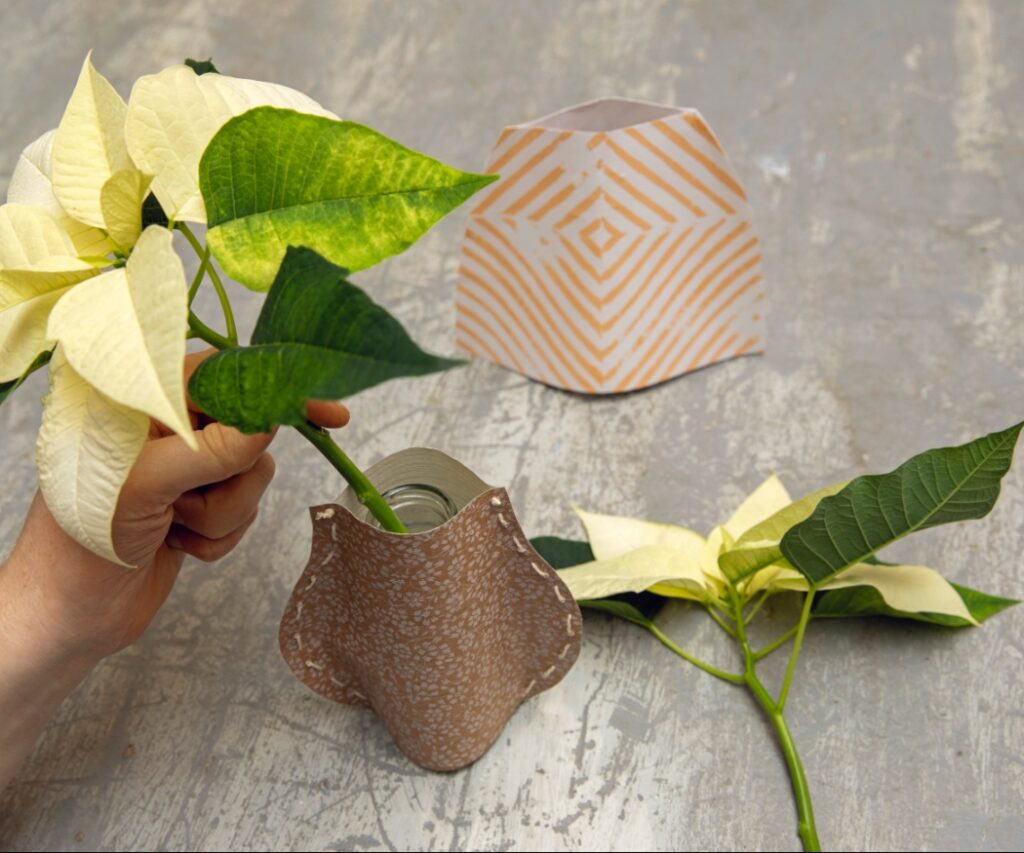
💡 Why do this? This stops the flow of sap from the stem, enabling the poinsettia to absorb water more easily and stay fresher for longer.
6 . Arrange and enjoy
Place the cut stems in the vases.You can also combine them with dried flowers, twigs, or other floral elements.
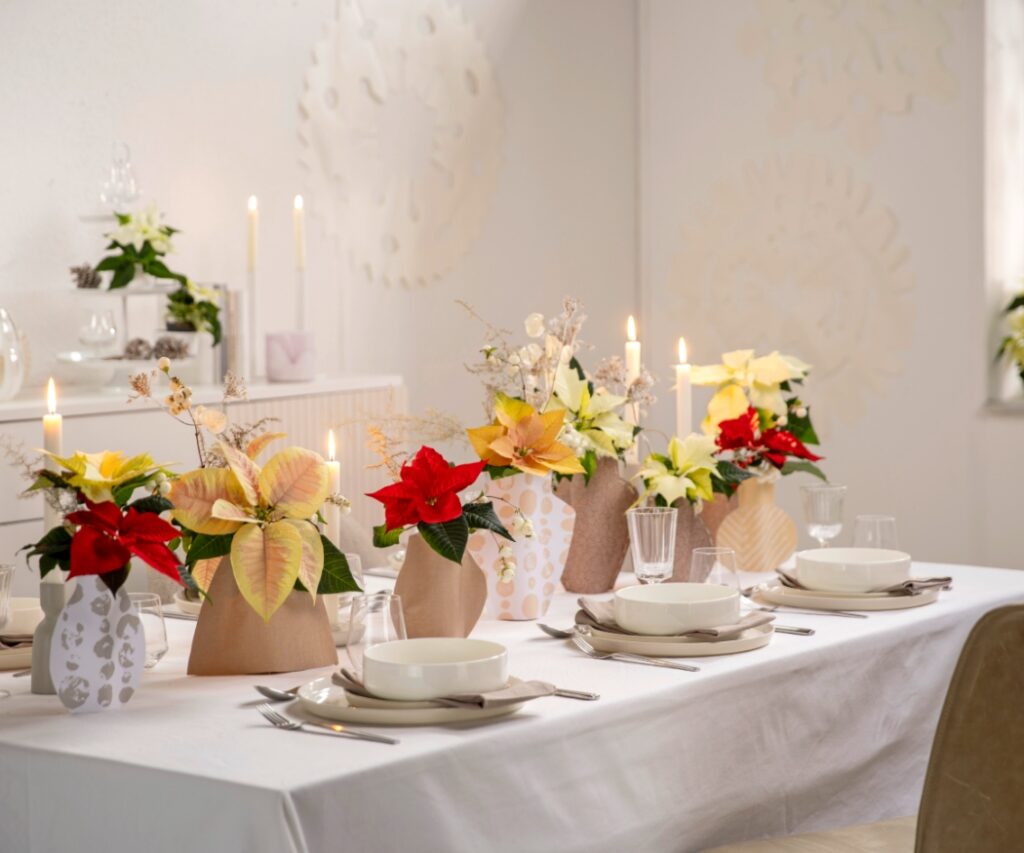
Tip for greater sustainability
Choose a wallpaper pattern in natural tones or with a simple texture to create a vase cover that can be used all year round. This transforms your winter décor into a timeless favourite you can fill with flowers or twigs again and again.
It saves resources and brings a homely feel to your space all year round.
Would you rather watch than read?
No problem, we’ve also made video instructions for you.
👉 Click here to watch YouTube tutorials on a homemade table decoration for after Christmas.
Why poinsettias are perfect for winter decoration
They last longer than you think
By following a few simple tips, you can keep your poinsettia healthy and beautiful for weeks on end. This means you can enjoy your decoration for longer.
👉 Find our care tips here.
They suit every style
Poinsettias are available in a variety of colours, ranging from the classic red and soft pink to cream, apricot and two-tone varieties. You’re sure to find one that suits you and your home perfectly!
👉 Discover the variety available here.
They often come from your region
Many poinsettias in the UK grow in regional nurseries – usually in family businesses that have been around for generations. When you buy regionally, you get fresh quality and support local people at the same time.
👉 Get tips for buying poinsettias here.
Low-waste – decorate sustainably
Sustainable decorating means using things for longer and throwing away less. If you keep your poinsettia for longer instead of throwing it away immediately after Christmas, you’re doing something good for the environment. You’re also saving money and creating a beautiful, meaningful home. Whether it’s a cut flower in your homemade vase or a potted plant: With a few simple steps, you can transform it into a decoration that looks and feels good.
A stylish winter table decoration to suit every style, from urban to Scandi.
Urban & creative
This is an ideal solution for small apartments, open-plan kitchens or narrow windowsills. All you need is an empty bottle covered in kraft paper or a scrap of patterned wallpaper. A white or apricot-coloured poinsettia will bring calm and brightness to your home in a simple way. Add a little tealight in a jam jar. No need for ornate candlesticks. That’s it!
Scandi and minimalist
Do you prefer a calm, natural look? Try this idea: a bottle with a cover made of pale, linen-effect wallpaper. Place a few twigs or some moss on a wooden tray. Add a soft pink or white poinsettia for a wintry touch.
Relaxed & informal
Love colour and want something a little more vibrant? Make the covers from colourful wrapping paper or quirky wallpaper offcuts. Take several bottles and fill each one with a different poinsettia stem. Place all the bottles together on a tray. This way, you can quickly move the decorations around. Colourful, cheerful and simple.
Sustainable winter table decorations: Four low-waste hacks
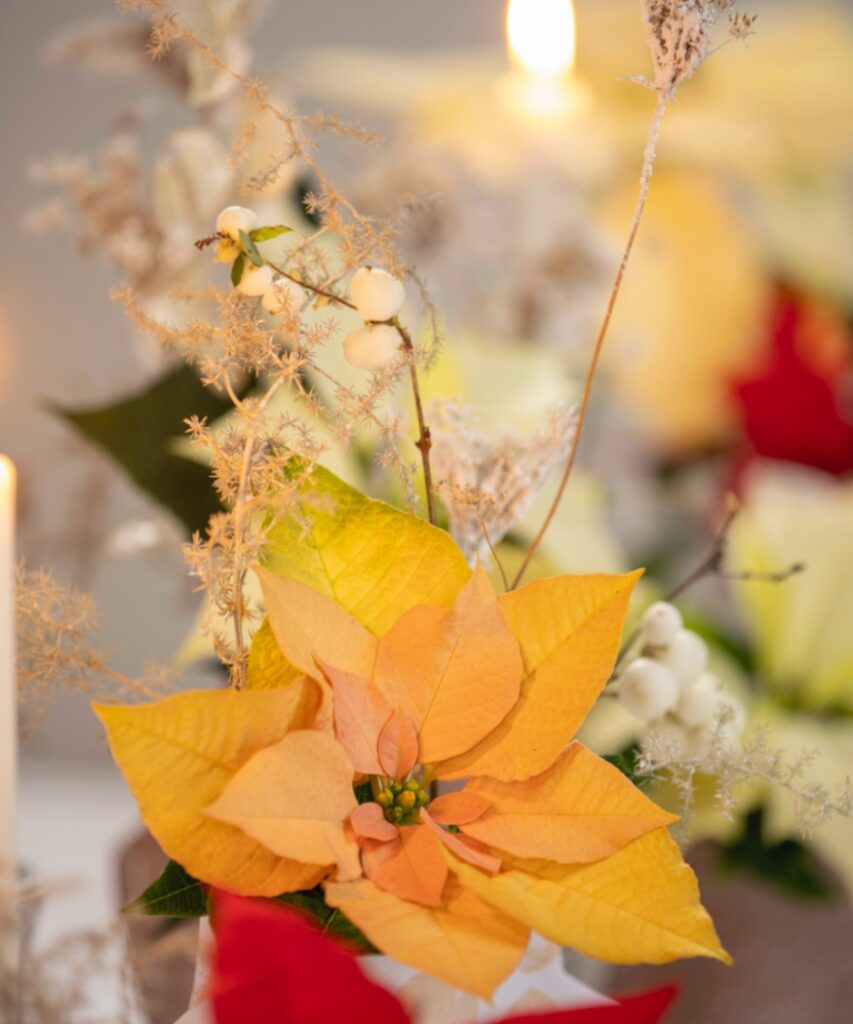
- Make use of what you already have
Old glass bottles can be transformed into beautiful vases. Use wallpaper scraps or wrapping paper as the cover. Instead of decorative ribbon, simply use a piece of string. You don’t have to buy anything new — just think differently! - Nature gives you decorations
Collect a twig on a walk, gather some dry moss from your balcony or pick up a piece of bark in the park. No plastic, no glitter. Just use what’s waiting for you outside. Quiet. Natural. Beautiful. - All you need is a little light
Take a jam jar and a tealight. An old, leftover candle is all you need! Place it next to your vase to create a warm glow. - Save poinsettias
Many people throw theirs away after Christmas. Ask your friends if they have any. You might receive one as a gift and give it a second life. This costs nothing and brings joy.
Why table decorations are good for you
Setting the table beautifully is good for you. Much more than you might think! It creates a calm and welcoming atmosphere. It encourages you to sit down, take a deep breath, and savour the moment. This is especially important during the long, dark winter months.
Biophilic design theory proves that natural elements such as plants, wood, daylight and natural tones in interior design have a positive effect on emotional wellbeing and the psyche. When you consciously decorate your table, you’re doing something good for yourself and your guests. Research has also been conducted into the effect of various colours and shapes. Warm colours and rounded, organic shapes are often perceived as calming and pleasant.
🎥 Quick tip: If you prefer to watch the instructions rather than read them, no problem – we’ve also included a video.
👉 Find the project tutorial on YouTube here.
Interior design: The poinsettia is back — and more beautiful than ever!
Poinsettias have long been much more than just festive decorations. Today, they are among the most popular plants with those who prefer a siple, natural and stylish approach to decorating. This also applies to the period before Advent and after Christmas.
An increasing number of designers and home bloggers are showcasing the beauty of poinsettias in modern homes. Interior design ideas featuring white, cream or apricot varieties are particularly popular. They fit perfectly with Scandi styles, boho looks or an urban jungle filled with plants.
This, in turn, fits well into a larger trend: Many people desire natural materials, long-lasting plants and mindful consumption. The poinsettia embodies all of these qualities. It is both classic and modern. This is why the plant is currently enjoying a real revival as the understated star of winter décor after the festive season.
FAQ: Everything you need to know about poinsettias and winter decorations
How can you transform Christmas displays into winter table centrepieces?
There’s no need to throw away your poinsettia after Christmas. Simply remove any festive decorations, such as cones, evergreen foliage, glitter or berries. Instead, pair the plant with paler, natural materials or dried flowers and you’ll have a beautiful decoration for the winter months.
What can you put on the table after Christmas?
Even after the festive season, your table can still look inviting. There’s no need for Christmas baubles, gnomes, Advent wreaths or evergreens. A cut poinsettia in a homemade vase, combined with dried flowers for example, is a perfect winter addition.
How long will a poinsettia plant last after Christmas?
With proper care, it can look beautiful from Advent through to spring. It’s important to place it in a bright but not too sunny location and to avoid overwatering or draughts.
How long will a cut poinsettia stem last in a vase?
Up to 14 days. It’s important to briefly immerse the stem in hot water (approx. 60°C) immediately after cutting, followed by cold water. Also, change the water every two days!
Are poinsettias poisonous?
Although cultivated varieties are considered largely safe, they are not suitable for consumption. Their milky sap can cause skin irritation in sensitive individuals. So, don’t eat them, avoid contact with mucous membranes and wash your hands if the sap comes into contact with them. Contact a doctor if children experience any symptoms.
Can I combine poinsettias with other things?
Yes, of course — they go very well together. They look striking teamed with dried flowers, grasses or delicate twigs. These will make your decorations look special, with a light, airy and natural look.
What colours are available besides red?
There are many beautiful shades, such as white, cream, pale pink, salmon, apricot and hot pink. There are even two-tone and variegated varieties. So you’re sure to find a poinsettia that suits you.
What should you do if a poinsettia plant loses its leaves?
This is often due to draughts or too much water. Move it to a warmer, more sheltered spot and water sparingly. Alternatively, cut off any healthy shoots and use them as cut stems in a vase. In some homes, your poinsettia may be in too dark a location. Give it a sunny spot, especially during the darker winter months.
What should you do with a poinsettia in January?
Don’t throw away your Christmas decor! You can either continue to use it as a cut flower or keep it in its pot and care for it. Place it in a bright spot away from draughts and keep the soil moist, but not soggy to keep it looking its best for longer.
What kind of winter table decorations suit small apartments?
Minimalist decorations are ideal for small spaces. A single glass vase containing a poinsettia stem is all you need.
Five things you (probably) didn’t know about poinsettias
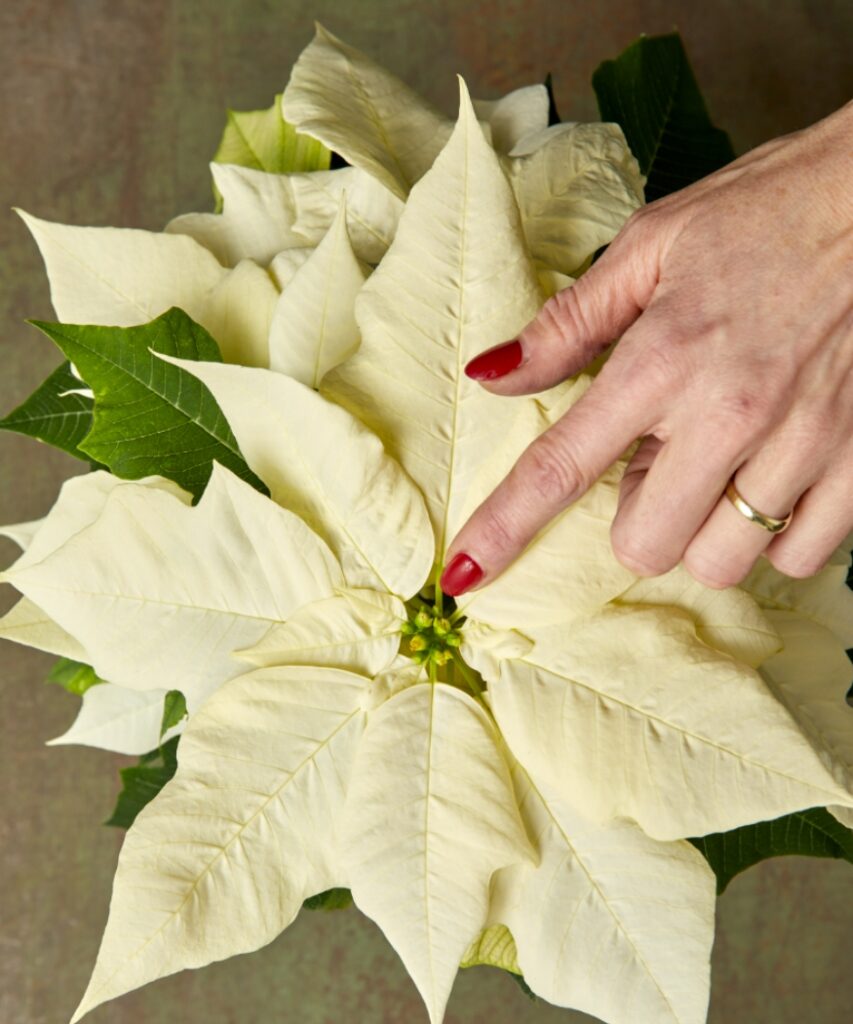
- They are called poinsettias, because the plant was brought to the US by Joel Poinsett, a US diplomat. He introduced the plant to the States from Mexico in the 19th century.
🔗 Read about the history of the poinsettia here. - The red “flowers” aren’t flowers at all
What look like flowers are actually bracts. The real flowers are inconspicuous and usually green or yellowish. They are located in the centre of the colourful bracts. - In Europe, poinsettias are grown regionally
In the UK, for example, most plants come from local nurseries, often family businesses that have been cultivating them for many years with great care and attention. - There are more than 150 varieties
The classic is red, but there are also pink, white, cream, salmon, apricot and two-tone varieties. In the UK, the red varieties are particularly popular.
🔗 Read more about the varieties here. - A poinsettia is not a disposable product
With a little care, it will look beautiful all winter long. You can also use individual cut stems for homemade decorations.
🔗 Get inspired here.
Expert knowledge: How to care for poinsettias properly and keep them healthy for longer
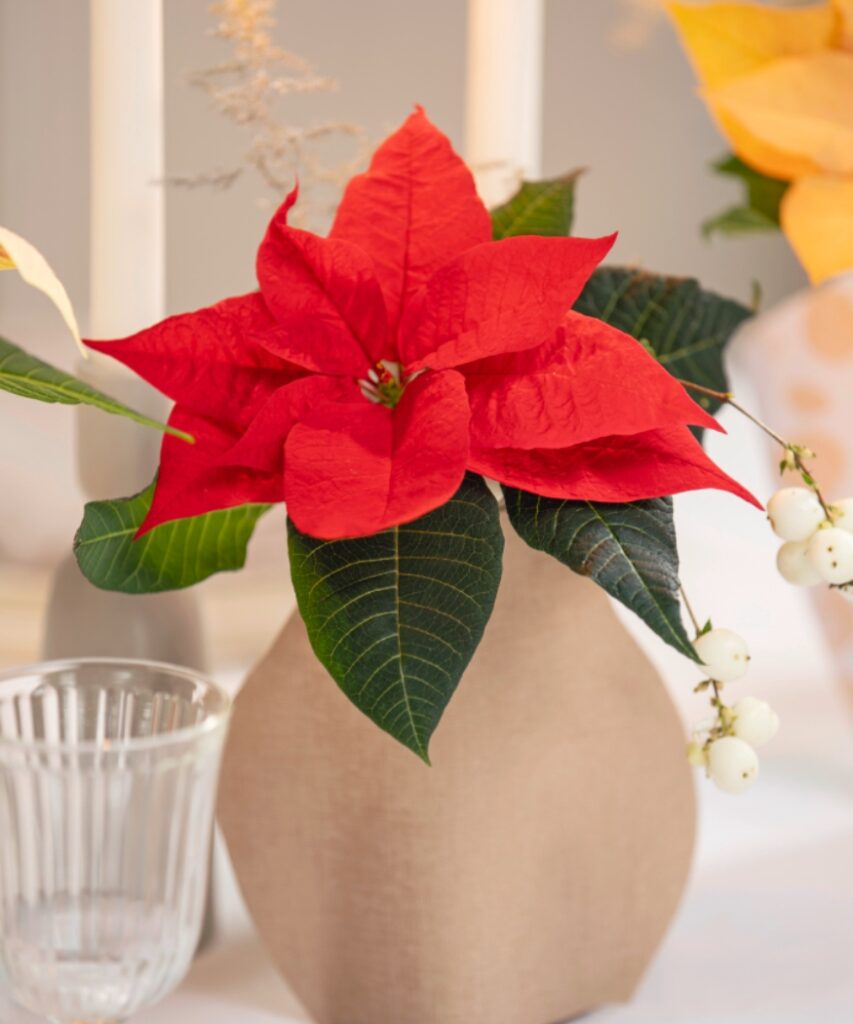
If you want to use your poinsettia in a craft project next year, there’s one thing it needs to do above all; stay healthy until after the festive season. This is easy with a few simple tips. You can start laying the groundwork for this from the moment you buy it.
Here’s how to care for your poinsettia properly:
🌞 A bright spot – but no draughts
Poinsettias like bright conditions and, in winter, they can enjoy full sun in Northern and Central Europe as they originate from sunny Central America. Temperatures between 15 and 22°C are ideal. Important: avoid placing poinsettias near heat sources or in cold draughts. This is the only way to keep the leaves on.
💧 Water when the soil is dry
Only water when the top of the soil feels slightly dry. Room-temperature water is best for the roots. We recommend either watering from below or immersing the plant in lukewarm water. For immersion, place it in water until bubbles stop rising. Drain thoroughly, then return it to its pot. Many houseplants dislike being waterlogged, so remove any water from the drip tray after 15 minutes.
🔗 How much water does a poinsettia really need?
After cutting: How to keep your cut poinsettia fresh in a vase
After cutting, immediately immerse the cut end in hot water (approximately 60°C) for a few seconds, then transfer to cold water. This stops the flow of milky sap, keeping the leaves fresher for longer. Place the stem in room-temperature water, away from heat sources and draughts. If you change the water every two days, the poinsettia should last up to two weeks in a vase.
Overwinter your poinsettia and encourage it to bloom again next year.
Don’t want to cut your poinsettia, but keep it as a potted plant? Then you can care for it over the summer and enjoy its beautiful colours again next winter. Here’s how:
Spring: Prune, rest and repot
In April, cut back all shoots to 15–20 cm. Water less. Your plant needs a rest in a bright spot that’s not too warm (15–18°C). Do not fertilise. In May, plant it in fresh compost.
Summer: Place it outside
If nighttime temperatures remain consistently above 12°C, you can put your poinsettia outside in the garden or on your balcony. Make sure it’s in a bright spot but away from direct midday sun. Keep the soil evenly moist, but don’t overwater.
Autumn: Begin the darkening period
From the end of September, your poinsettia needs at least 12 hours of darkness every day for six to eight weeks. One way to achieve this is to place a cardboard box over the pot at night. Only with this treatment will the bracts regain their colour in time for Advent.
Winter: Enjoy the colours
After the darkening period, your poinsettia can return to the light. It’s best to put it near a window. If all goes well, it will display its new blooms in November or December. It’s not easy, but with a little patience and love, it can work.
🔗 Find detailed instructions here: How to overwinter poinsettias and make them bloom again.
Glossary
Upcycling
The process of transforming something you would normally throw away into something new and useful. Example: Turning an old bottle into a vase.
Low-waste
Producing less waste. This involves using things for longer or reusing them in creative ways instead of throwing them away.
Bracts
The colourful leaves of the poinsettia that look like flowers. The real flowers are small and located in the centre.
Darkening phase
A period during which a plant, such as the poinsettia, requires many hours of darkness every day in order to bloom. For poinsettias, this is more than 12 hours.
Waterlogging
This occurs when a plant and its pot are placed in water and liquid remains in a pot after watering. This can damage the roots.
Interior design:
English for ‘interior design’. It’s about making rooms look beautiful, practical and inviting.
Scandi style
An interior design style from Northern Europe. Typical features include pale colours, plenty of wood, clean shapes and natural materials.
Boho style
Short for ‘Bohemian style’. This is a colourful, relaxed interior design style with lots of fabrics, patterns and plants.
Urban Jungle
A decor style incorporating lots of plants. The home feels like a small jungle — both living and welcoming.
Biophilic design
This is where buildings and spaces are designed to make people feel more connected to nature. The aim is to incorporate elements such as plants, wood, ample lighting and water into homes. This makes people feel more comfortable and healthier. The tendency to like nature and feel better in its presence is called “biophilia”.
 English
English Dansk
Dansk Deutsch
Deutsch English
English Español
Español Français
Français Hrvatski
Hrvatski Italiano
Italiano Magyar
Magyar Nederlands
Nederlands Norsk
Norsk Polski
Polski Română
Română Slovenský
Slovenský Slovenščina
Slovenščina Suomi
Suomi Svenska
Svenska Čeština
Čeština Ελληνική
Ελληνική Български
Български
